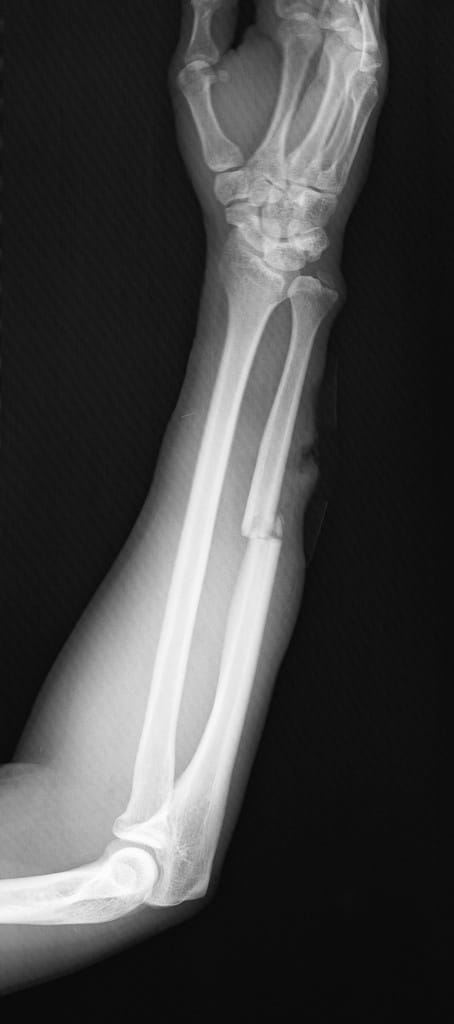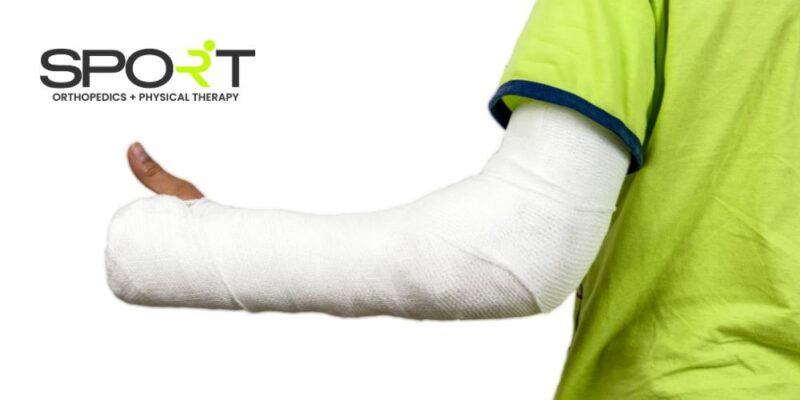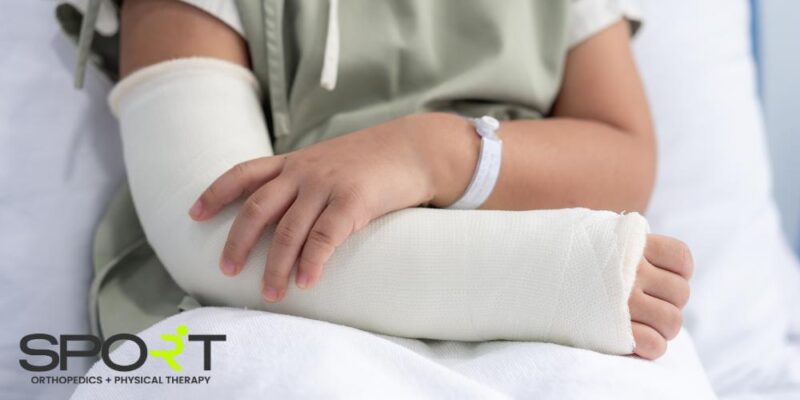Ulna Fracture Treatment in Dallas, Frisco, Prosper, and Wylie
Forearm Fracture Treatment
Forearm Fracture Symptoms and Treatment
The forearm consists of two very important bones: the radius and the ulna. The radius is the larger forearm bone on the same side of the arm as the thumb, and the ulna is the smaller bone on the opposite side. As you can probably imagine, immediate treatment of a broken arm is crucial. Because we use these parts of our body every day, we want to ensure as smooth a recovery as possible. Even for a small hairline ulna fracture, it’s important not to put off ulna fracture treatment.
At SPORT Orthopedics + Physical Therapy, we offer a wide range of treatment options for all sorts of broken bones. In many cases of forearm fractures in adults, both ulna fractures and radius fractures are present. Thus, our Dallas orthopedic specialists pride themselves on their extensive treatment knowledge. If you suffered an ulna fracture, we’re here to help. To schedule an appointment with us, please call our office at 469-200-2832 today, or fill out our online intake form.
What Is an Ulna Fracture?
A fracture of the ulna affects the forearm bone on the same side as your pinky. This bone narrows toward the hand and widens toward the elbow, actually forming the elbow “point.” Fractures of this bone can occur at any point along the bone, and have different descriptors depending on the location. Fractures near the wrist are distal fractures. Those in the middle of the bone or near the elbow are proximal fractures. As we stated previously, it is common to fracture both the radius and the ulna at the same time.
Bones in the forearm can shatter in a variety of ways. The bone might either break slightly or shatter into many fragments. Any fractured bone pieces may be perfectly aligned or may be out of place. The bone may shatter in such a way that bone pieces protrude through the skin or a wound penetrates down to the damaged bone in some situations. Because of the potential for infection, this is an open fracture, which requires rapid medical treatment.
Adults are more likely to shatter both bones following a forearm injury due to the high force necessary to break the radius or ulna in the center of the bone. Usually, if only one bone breaks, it is the ulna. The break often results from a direct blow to the arm, as when people raise their arm to defend themselves.
Types of Forearm Fractures
Fractures of either bone or both the radius and ulna are possible. An isolated ulnar shaft fracture is one that does not affect the radius and is caused either by indirect trauma or a harsh blow to the bone. An ulnar styloid fracture is an ulna fracture that occurs at the wrist joint.
Specific fractures, Galeazzi and Monteggia, occur when the bones break at separate levels, and the joints at the wrist or elbow sustain damage.
- Galeazzi fracture: This is a displaced radius fracture with a dislocated ulna at the wrist joint.
- Monteggia fracture: This is an ulna fracture with a radius dislocation at the elbow joint.

What Causes an Ulna Fracture?
Many upper extremity fractures have similar causes, such as indirect trauma during a fall, direct blows to the forearm, and others. Forearm fractures have three common causes that make up the bulk of the cases we see.
- Direct blows to the forearm
- A fall on an outstretched arm, usually while playing sports or falling from a height
- Motorcycle or motor vehicle accidents
How to Diagnose an Ulna Fracture

Initial treatment usually begins when people visit the emergency room or an urgent care center. First, explain to your doctor how the injury occurred. Did you fall off of something? How far did you fall? Additionally, let your doctor know if you suffered other injuries.
Also, explain other medical issues you might have, and outline the medications you take. Once your doctor has enough information about your medical history and symptoms, they will perform an examination. During the examination, they do the following.
- Examine your skin to determine whether the damage has caused any cuts. Lacerations can be caused by bone particles breaking through the skin. As a result, there is a higher chance of infection.
- Feel your arm from end to end to see if there are any additional sensitive spots. This might be a sign of more fractured bones or injuries.
- Check your wrist pulse to ensure that blood gets through your forearm to your hand.
- Examine your fingers and wrist to check whether you can move them and feel things with them. Nerves can be damaged at the same time that a bone is shattered, resulting in numbness and weakness in the hands and wrists.
The most popular and commonly used diagnostic imaging method is X-rays. X-rays can reveal if a bone is fractured and whether it has been displaced. They can also indicate how many fractured bones are present. Your doctor will likely perform a physical exam before ordering an X-ray of the injured forearm to confirm the fracture.
Ulna Fracture Symptoms
As with many breaks, the first symptom is usually pain. In cases where both the radius and the ulna fracture, the arm tends to deform. The arm either appears shorter than the other arm or bent in an unnatural way. Many people need to support the broken arm with their other hand in order to hold it up. Below, we list other notable symptoms associated with an ulna fracture.
- Swelling
- Bruising
- Difficulty or inability to rotate the arm
- Distal radioulnar joint instability
- Weakness or numbness in the wrist or fingers
Ulna Fracture Treatment

Broken bones are treated in the same way as other shattered bones: the broken parts must be repositioned and kept from moving until they mend. It’s critical that the radius and ulna are adequately stabilized because they rely on each other for support. If the bones are not precisely aligned throughout the healing process, subsequent wrist and elbow mobility issues may occur. While many adult forearm fractures require surgery to align and stabilize the bones, this is not always the immediate treatment.
Immediate Care
Depending on how far the parts are out of position, the doctor may try to realign them temporarily while you’re in the emergency room. The precise name for the process in which the doctor puts the parts into position is “reduction.” This isn’t a surgical operation. Medication will help you manage your pain. Your doctor then will put a splint (similar to a cast) on your forearm and equip you with a sling to hold your arm in place.
A splint, unlike a complete cast, may be tightened or relaxed and allows for safe swelling. Controlling the mobility of a fractured bone is critical. Moving a fractured bone can result in further injury to the bone, adjacent blood vessels, nerves, and other structures. Additional orthopedic urgent care will include the use of ice to decrease swelling and the administration of pain medication.
Nonsurgical Treatment
If you only fracture one bone and it is not displaced, a cast or brace is likely sufficient. Your doctor will carefully monitor your fracture’s healing and schedule regular check-ups for X-rays. If this is not enough, your doctor might recommend fracture surgery.
Surgical Treatment
Surgery is generally ideal when someone breaks both forearm bones, or if the bones puncture the skin. Open fractures are generally scheduled for surgery right away due to the increased risk of infection. In the emergency room, patients are usually administered antibiotics through an IV and may be given a tetanus injection.
The cuts from the injury will be properly cleaned out during surgery. The fractured bones are usually repaired at the same time. If the skin around the fracture has not been broken, your doctor may advise you to wait until the swelling has subsided before undergoing surgery. Swelling can be reduced by immobilizing and elevating your arm for a few days. It also provides an opportunity for stretched skin to heal.
Types of Surgical Repair of Ulna Fractures
Open reduction and internal fixation (plates and screws): This is the most frequent surgical procedure for treating ulna fractures. The bone pieces are initially realigned (reduced) into their natural alignment during this operation. Special screws and metal plates connected to the bone’s exterior surface hold them together.
Open reduction and internal fixation (rods): A specifically constructed metal rod is introduced into the marrow area in the middle of the bone during this surgery.
External fixation: If the skin and bone have been badly injured, plates and screws, as well as extensive incisions, may further harm the skin. This might lead to infection. An external fixator may be used in this situation. Metal pins or screws are inserted into the bone above and below the fracture site in this procedure. Outside the skin, the pins and screws are connected to a bar. This device is a stabilizing frame that keeps the bones in place so they can recover properly.
Complications in Forearm Fracture Treatment

Sometimes, forearm fractures cause significant injury to the surrounding tissue, leading to complications. Broken bones frequently have sharp edges that can slash or tear nearby blood vessels or nerves.
Acute compartment syndrome is a disease in which the swelling cuts off blood flow to the hand and forearm. It results from excessive bleeding and swelling soon after an injury. It usually happens within 24 to 48 hours of the accident and produces excruciating agony when the fingers are moved.
When compartment syndrome occurs, it can cause loss of feeling and function, and it necessitates immediate surgery. To relieve pressure and enable blood to return, the skin and muscle covers are opened and left open in such instances.
An open fracture exposes the bone to the elements. The bone might get infected even after a thorough surgical cleansing of the bone and muscle. Bone infection is tough to cure and frequently necessitates numerous operations as well as long-term antibiotic treatment.
Surgical Complications
Every operation comes with its own set of hazards. If your doctor suggests surgery, it means he or she believes the potential advantages exceed the risks.
- Infection: Any surgery comes with the risk of infection.
- Blood vessels or nerve damage: Although a minor risk, it is possible to damage the nerves or blood vessels. If you have persistent numbness or tingling in the fingers, speak to your doctor right away.
- Synostosis: This is a rare complication that decreases the range of motion of the bones.
- Nonunion: While surgery does help, it does not guarantee healing. Sometimes, fractures pull apart, or the hardware within the arm shifts or breaks.
What Is Forearm Fracture Recovery Like?
Bones have an amazing ability to repair. It usually takes 3 to 6 months for forearm bones to totally recover. However, the more serious your injury, the longer it may take for you to recuperate. One of the most important steps in recovery is pain management. Fractures are extremely painful. Thus, it is important to follow all directions regarding pain medications very closely. Some doctors prescribe opioids in severe cases, but these can be addictive. Only take medications as directed by your doctor.
After nonsurgical treatment, you undergo rehabilitation. After a few weeks, you might undergo Dallas physical therapy to increase your range of motion and gradually strengthen the arm. A cast or brace may be required for 2 to 6 weeks following surgery, depending on the intricacy of the fracture and the stability of the repair.
Shortly after surgery, motion exercises for the forearm, elbow, and wrist usually begin. The importance of early mobility in preventing stiffness cannot be overstated. Depending on how long your arm was immobile, your doctor may also recommend visits to a physical therapist.
Ulna Fracture FAQs

How Is a Distal Ulna Fracture Treated?
Distal ulna fractures, also called isolated ulnar shaft fractures, are fractures of the ulna that occur near the wrist. Any forearm fracture that occurs along the length of the ulna bone or radius bone is a distal fracture. A distal forearm fracture can occur anywhere along the length of the forearm bones, such as near the wrist, near the elbow, or in the middle of the bone.
Distal radius fractures are similar to distal ulna fractures in that they are the same fracture, just on a different bone. A distal radius fracture or distal ulna fracture can be treated either conservatively or surgically. Conservative treatments involve having the patient wear a functional brace or cast for around 4-6 weeks.
Surgical treatment options for distal ulna fractures and distal radius fractures include open reduction internal fixation, external fixation, or intramedullary nailing. Your orthopedic surgeon will evaluate the extent of the damage to your arm and develop a personalized treatment plan for you.
How Serious Is an Ulna Fracture?
Any broken bone is a serious injury that may or may not require surgery to correct. However, radial and ulnar shaft fractures are among the most common broken bones. While they are very painful, the outlook of these injuries is very good with proper treatment.
If you suspect you may have an isolated ulnar shaft fracture, the best thing to do is speak with an orthopedic surgeon right away. The longer you wait to receive treatment, the more likely it is that you will experience complications from the injury. There is also a possibility that, without prompt treatment, the bone may heal improperly and impair your arm’s function.
How Long Does an Ulna Fracture Take to Heal?
Usually, patients can return to their normal activities after about six weeks of healing. They can return to manual labor after around three to four months. By the six-month mark, the bone should be completely healed.
Keep in mind that the full recovery time will depend on several factors, such as the severity of the injury and whether or not any complications occur. For a better idea of how long your injury may take to fully heal, we recommend speaking with your doctor.
Can You Move Your Hand After an Ulna Fracture?
In some cases, ulna fractures can impair the movement of the arm. It will likely be painful to move the arm, hand, or wrist after the injury occurs. During healing, a brace or cast will hold the bones of the affected arm in place. The wrist and hand will likely be held in certain positions as well to promote healing.
Do Ulna Fractures Need a Cast?
Usually, yes. Casts and braces are common forms of treatment for adult forearm fractures, either to the radius or ulna. Immobilizing the forearm in this way holds the bones in proper alignment and promotes healing. If the fracture is severe, surgery may be required to stabilize the bones internally before a cast or brace is applied.
Ulnar Fracture Treatment in Dallas, Frisco, Wylie, and Prosper at SPORT Orthopedics
After sustaining a serious injury, it’s very easy to feel isolated or alone, as it prevents you from doing what you love. Although recovery takes time, working with a highly experienced orthopedic specialist and physical therapist can help reduce the time between your injury and a full recovery. At SPORT, our main goal is to get you back to doing what you love while providing top-of-the-line care. If you suffered an ulna fracture or other injury, please give us a call at 469-200-2832 today.


